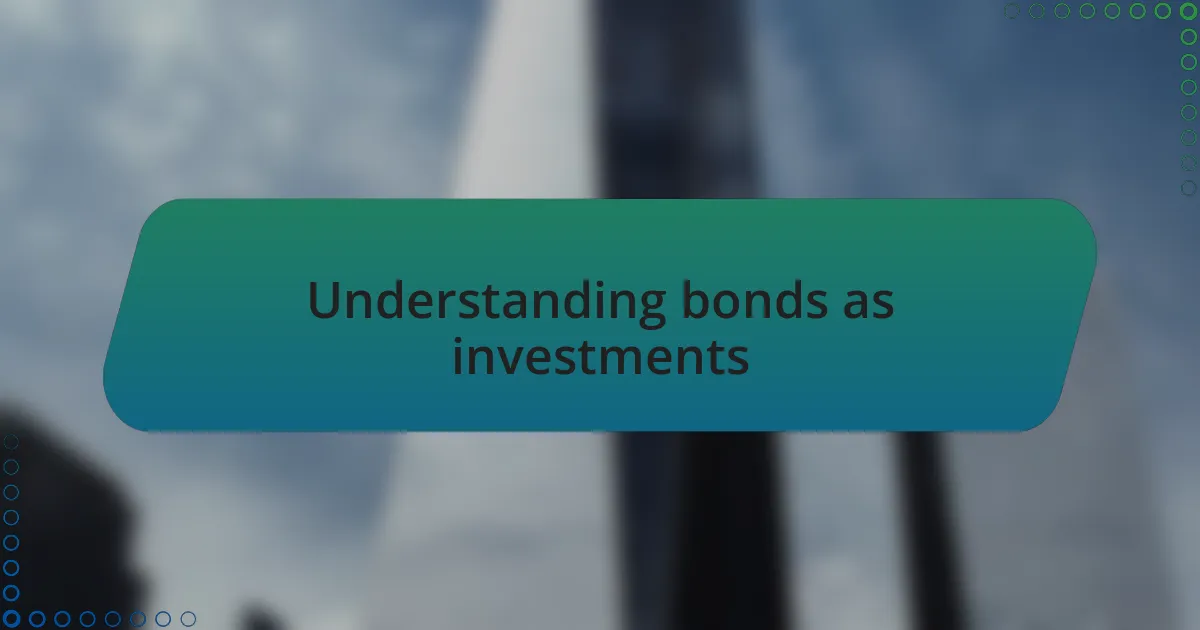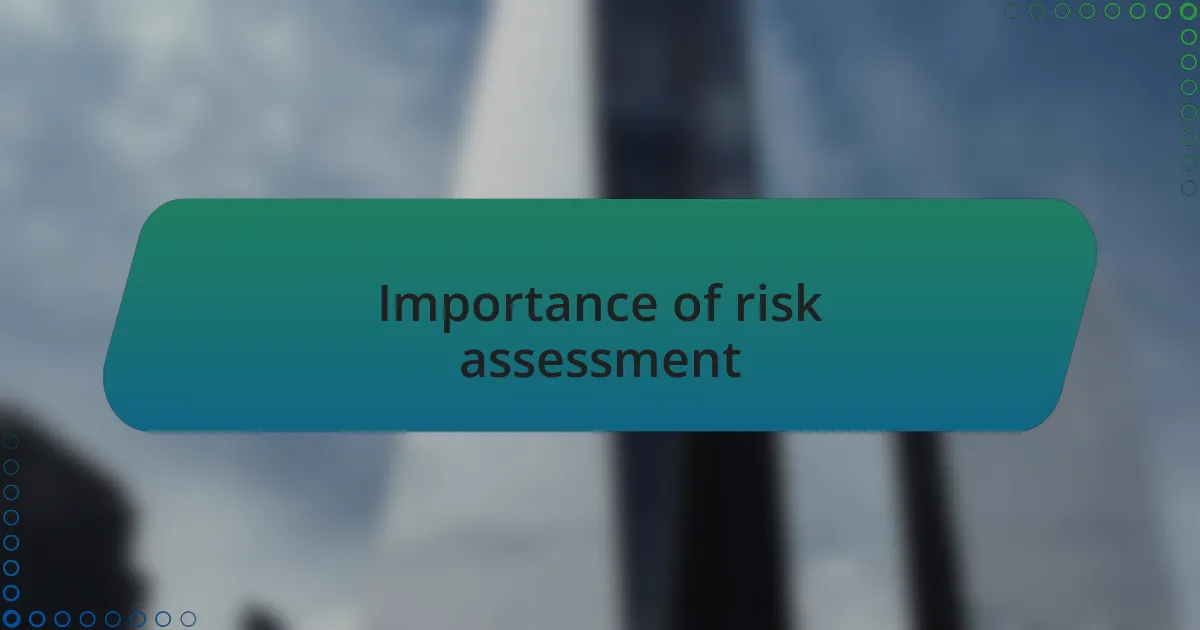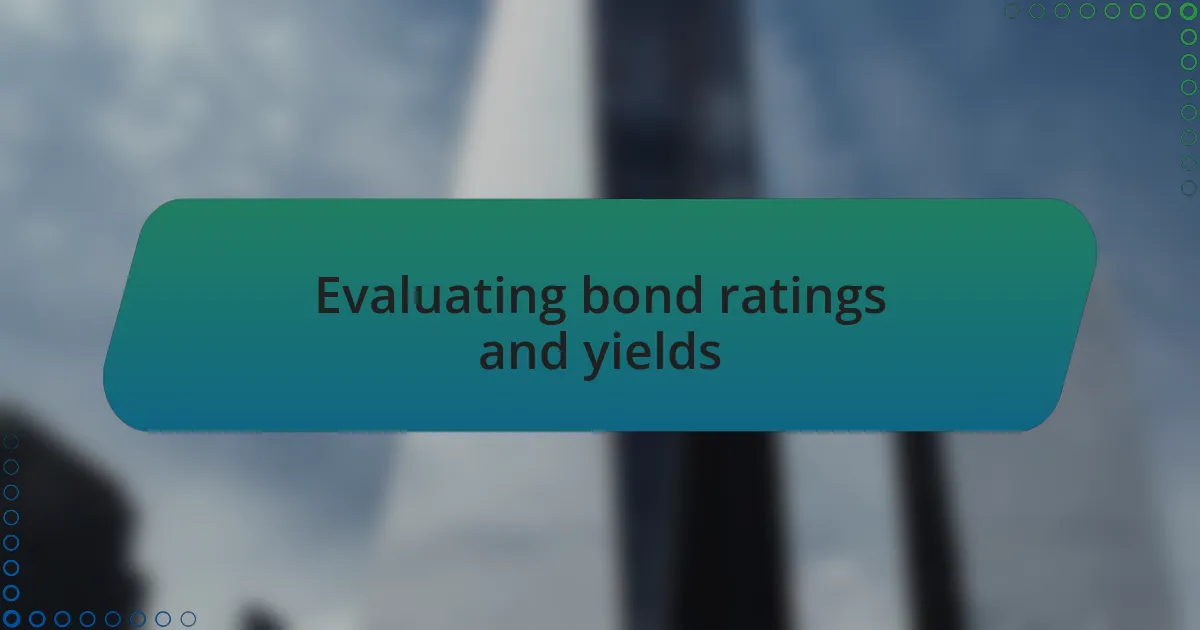Key takeaways:
- Bonds are considered a safer investment compared to stocks, offering steady income through interest payments, but require understanding of issuer creditworthiness and market conditions.
- Effective risk assessment is crucial in bond investing, involving the evaluation of interest rate risk, credit risk, and other factors to protect investments and build confidence.
- Bond ratings and yields must be balanced; high yields may come with higher risks, and investors should align these with their personal values and investment strategies.
- Diversification, continuous market awareness, and setting clear investment goals are essential for successful bond investing, helping to navigate changes in economic conditions and personal financial objectives.

Understanding bonds as investments
Bonds are often seen as a safer alternative to stocks, providing a steady stream of income through interest payments. I recall my first experience investing in bonds; it felt reassuring to know I had a predictable return, unlike the unpredictable stock market. Understanding why bonds fluctuate, especially with interest rates, is crucial for maximizing your investment.
When I assess bonds, I consider not just the yield but also the credit risk associated with the issuer. Have you ever thought about what happens if a company defaults? It’s a sobering consideration that drives home the importance of researching the issuer’s creditworthiness. That’s where tools like credit ratings come into play, offering insights into the likelihood of repayment.
Moreover, the different types of bonds — corporate, municipal, or treasury — each serve unique purposes in a portfolio. I often think about how municipal bonds, for example, not only offer tax advantages but also contribute to community development. This dual benefit can make them especially appealing to those of us who want our investments to align with our values. The depth of understanding one gains about bonds can truly shape investment strategy.

Importance of risk assessment
When I think about the importance of risk assessment in bond investing, I can’t help but reflect on a time when I overlooked a critical aspect and faced a disappointing outcome. Evaluating the potential risks associated with a bond can significantly impact my investment returns. It’s not just about the potential interest; it’s about understanding the worst-case scenario and preparing for it. Have you ever faced a surprise loss that made you rethink your strategies?
Each bond comes with its own set of risk factors—interest rate risk, credit risk, and liquidity risk, to name a few. Just the other day, I was reviewing some corporate bonds, and I noticed a higher yield that initially caught my attention. However, after digging deeper into the issuer’s financial health, I realized the risks were greater than I was willing to take. This immediate realization reinforced my belief that comprehensive risk assessment is non-negotiable.
Moreover, I find it fascinating how a well-rounded risk assessment not only protects me but also helps in building confidence in my investment decisions. I often revisit my assessments after major market events to see if my previous evaluations hold up. This ongoing analysis ensures that I’m not just reactive but proactive in my approach, ultimately leading to a more resilient investment strategy. How often do you check your risk assessments?

Evaluating bond ratings and yields
When evaluating bond ratings, I often refer to the ratings provided by agencies like Moody’s, S&P, and Fitch. These ratings give me a quick insight into the creditworthiness of the issuer, which is crucial for risk assessment. I remember a time I was tempted to invest in a high-yield bond with a lower rating; the lure of higher returns was strong, but the potential for default loomed large. Do you weigh the allure of yield against the risks that come with lower ratings?
Yields, on the other hand, serve as the bond’s incentive. A bond’s yield might look attractive on paper, but I’ve learned to dig deeper to understand the context behind that number. For instance, I once invested in a bond that offered a seemingly amazing yield, only to find out it was a reflection of market volatility rather than solid fundamentals. It’s essential to consider whether a high yield comes with a safety net or is simply the market’s way of warning me.
In my experience, striking a balance between bond ratings and yields requires thoughtful consideration. After all, a bond might have a solid rating but a low yield that doesn’t align with my investment objectives. Sharing this journey with other investors has reminded me that understanding these financial indicators transcends mere numbers—it’s about aligning them with my personal values and long-term goals. How do your valuations align with your investment philosophy?

Factors influencing bond prices
There are several factors that play a significant role in influencing bond prices, and one of the most critical is interest rates. When interest rates rise, existing bonds with lower rates often see their prices drop, as new issues become more attractive. I recall analyzing my bond portfolio during a rate hike and watching the values shift practically overnight. Have you ever felt that jolt when market conditions change unexpectedly?
Another factor that impacts bond prices is the issuer’s creditworthiness, which ties back to bond ratings. A downgrade can shake investor confidence, resulting in falling prices. I once held a municipal bond that was downgraded due to fiscal struggles in the issuing city. I had to make a tough choice between holding on, hoping for recovery, or cutting my losses. Have you faced a similar dilemma with your investments?
Economic conditions also play a vital role in determining bond prices. For instance, during economic downturns, investors tend to flock to safer bonds, pushing their prices up while riskier assets suffer. I remember a time when the market was volatile, and I felt a sense of relief watching my bonds hold value while stocks fluctuated wildly. How do economic shifts impact your investment strategy?

My personal investment criteria
When it comes to my personal investment criteria for bonds, I always prioritize yield versus risk. I vividly recall a time when I encountered a bond with a tempting yield but buried within the fine print was a much higher risk than I was comfortable with. This taught me to look beyond just the potential returns; I now weigh them against the stability of the issuer and their financial health. Have you ever been lured by a high yield only to realize the underlying risks?
Liquidity is another major factor I consider. There was an instance when I held a bond that seemed perfect on paper, but I faced challenges when I needed to sell it in a pinch. The market for that particular bond was thin, and I learned the hard way that not all bonds are easy to trade. Have you experienced that sense of frustration in trying to access your investments?
Lastly, I focus on the bond’s maturity profile. Shorter maturities can be a safeguard against rising interest rates. During a period of rising rates, I re-evaluated my portfolio and swapped some longer-term bonds for shorter ones tied to a specific horizon. The peace of mind I gained was invaluable—how do you navigate the timeline of your bond investments?

Tips for successful bond investing
When it comes to bond investing, diversification is key. Early in my investment journey, I made the mistake of putting too much of my capital into a single bond issuer. I felt a wave of panic when that company faced financial difficulties, and I quickly realized the importance of spreading my investments across different sectors and credit ratings. Have you thought about how diversified your bond portfolio really is?
Another essential tip is to stay informed about interest rates and market conditions. I once overlooked a significant change in the economic landscape, which left me holding bonds that became less attractive as rates climbed. This experience underscored for me the need to continuously educate myself about the factors affecting bond prices. How often do you check on the broader financial trends?
Lastly, I find that setting clear investment goals is crucial. For example, when I was planning for a major life event, like buying a home, I tailored my bond investments to align with that timeline. This not only helped me track my progress but also provided me with a clear strategy to follow. What specific goals drive your bond investments?